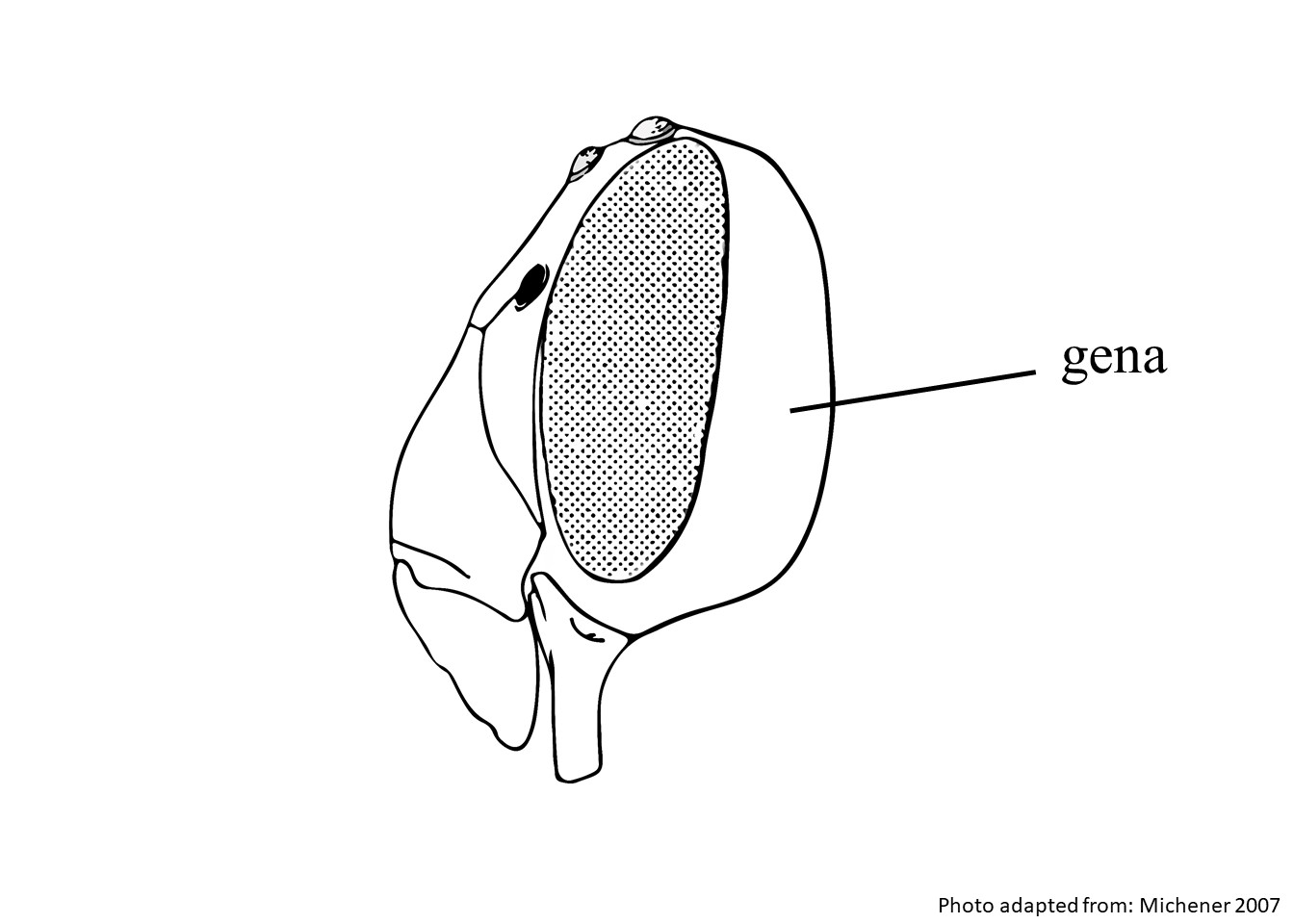Family: Megachilidae
Subfamily: Megachilinae
Tribe: Osmiini
Genus: Osmia Panzer, 1806
Subgenus: Euthosmia Sinha, 1958
Common name: none
Osmia (Euthosmia) are slender, blue-green bees with white hairs (Michener 2007Michener 2007:
Michener, C.D. 2007. The Bees of the World (2nd ed.). Johns Hopkins University Press, Baltimore and London, 953 pp.). They range in body length from 5–7 mm.
(modified from Michener 2007Michener 2007:
Michener, C.D. 2007. The Bees of the World (2nd ed.). Johns Hopkins University Press, Baltimore and London, 953 pp., unless otherwise stated)
 narrower than the eye in profile.
narrower than the eye in profile. .
. apicalapical:
apicalapical: is not enlarged.
is not enlarged. , S3S3:
, S3S3: , and S4S4:
, and S4S4: are transverse.
are transverse.Osmia (Euthosmia) may be confused with O. (Melanosmia) due to a lack of enlarged S2S2:
the plates on the underside of the abdomen, often abbreviated when referring to a specific segment to S1, S2, S3, S4, S5, S6, S7, or S8
 and transverse S2S2:
and transverse S2S2:
the plates on the underside of the abdomen, often abbreviated when referring to a specific segment to S1, S2, S3, S4, S5, S6, S7, or S8
 , S3S3:
, S3S3:
the plates on the underside of the abdomen, often abbreviated when referring to a specific segment to S1, S2, S3, S4, S5, S6, S7, or S8
 , and S4S4:
, and S4S4:
the plates on the underside of the abdomen, often abbreviated when referring to a specific segment to S1, S2, S3, S4, S5, S6, S7, or S8
 . However, they can be differentiated by the above diagnostic characteristics (Michener 2007Michener 2007:
. However, they can be differentiated by the above diagnostic characteristics (Michener 2007Michener 2007:
Michener, C.D. 2007. The Bees of the World (2nd ed.). Johns Hopkins University Press, Baltimore and London, 953 pp.).
Analysis of pollen found in O. (Euthosmia) glauca nests shows that they collect pollen from Collinsia spp., and are suspected to be specialists on this genus (Rust and Clement 1972Rust and Clement 1972:
Rust, R.W. and S.L. Clement. 1972. The biology of Osmia glauca and Osmia nemoris. Journal of the Kansas Entomological Society 46: 548ndash;562.).
Osmia (Euthosmia) construct nest cells out of mud in hollow stems and abandoned Sceliphron nests. Nest cells are made in clusters or in linear arrangements depending on the cavity used (Rust and Clement 1972Rust and Clement 1972:
Rust, R.W. and S.L. Clement. 1972. The biology of Osmia glauca and Osmia nemoris. Journal of the Kansas Entomological Society 46: 548ndash;562.).
Osmia (Euthosmia) contains one species, O. glauca (Michener 2007Michener 2007:
Michener, C.D. 2007. The Bees of the World (2nd ed.). Johns Hopkins University Press, Baltimore and London, 953 pp.).
Osmia (Euthosmia) can be found in the U.S. west of the Rocky Mountains, primarily in California (Michener 2007Michener 2007:
Michener, C.D. 2007. The Bees of the World (2nd ed.). Johns Hopkins University Press, Baltimore and London, 953 pp.; GBIF 2019GBIF 2019:
GBIF.org. 14 June 2019. GBIF Occurrence Download https://doi.org/10.15468/dl.wmukot).
Distribution map generated by Discover Life -- click on map for details, credits, and terms of use.
GBIF.org (14 June 2019) GBIF Occurrence Download https://doi.org/10.15468/dl.wmukot
Michener, C.D. 2007. The Bees of the World. 2nd ed. Johns Hopkins University Press, Baltimore and London, 953 pp.
Rust, R.W. and S.L. Clement. 1972. The biology of Osmia glauca and Osmia nemoris. Journal of the Kansas Entomological Society 46: 548-562.